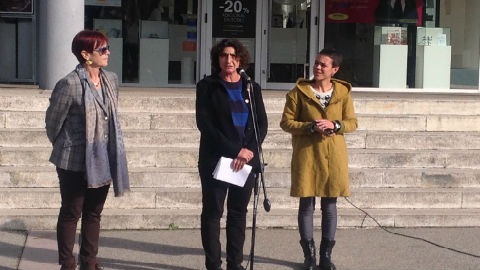The UAB pays homage to all victims of gender violence

24/11/2016
Rector of the UAB Margarita Arboix, Vice Rector of Students and Employability Sara Moreno, and Director of the Observatory for Equality Joana Gallego, presided over the minute of silence which took place at the Bellaterra campus at noon on 25 November in memory of the victims of gender violence.
The initiative formed part of the International Day for the Elimination of Violence against Women and was organised by the UAB Observatory for Equality. In addition to the minute of silence, the university community exhibited symbols in sign of protest against gender violence. A purple ribbon was placed on the front of the Edifici Àgora. Following the minute of silence, the UAB's manifest against gender violence was read out at the Plaça Cívica.
The International Day for the Elimination of Violence against Women was celebrated for the first time in 1981. In 1993, the United Nations passed the Declaration on the Elimination of Violence against Women, defining it as "any act of gender-based violence that results in, or is likely to result in, physical, sexual or psychological harm or suffering to women, including threats of such acts, coercion or arbitrary deprivation of liberty, whether occurring in public or in private life".
This declaration helped consolidate the fight against this type of violence on behalf of all governmental and non-governmental institutions, which culminated in 1999, with the official designation by the United Nations of 25 November as the International Day for the Elimination of Violence against Women.
The Observatory for Equality is focused on the analysis of inequalities in higher education, and specifically on the study and diagnosis of sexism and inequalities for the disabled, from an intersectional perspective. This unit began its activities at the UAB in 2005, and worked mainly fighting against inequalities between women and men. In 2008, it grew to act in favour of all collectives which could find themselves in unfavourable conditions due to their physical, economic, or social situation (immigration, age, sexual orientation, etc.).